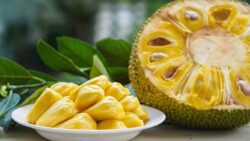You may be interested in learning how to tell when the fruit is ready for picking if you are fortunate enough to have a Jackfruit tree that is starting to bear fruit. If you are also fortunate enough to live close to a market that sells fresh jackfruit, you might be interested in learning how to identify a ripe jackfruit for consumption. And lastly, how can you make a freshly picked jackfruit mature faster if it is still too green to eat? First, how should jackfruit be ripened?
What is Jackfruit ?
Jackfruit is a tropical fruit known for its large size, unique flavor, and versatility in cooking. When it comes to enjoying jackfruit, it’s essential to let it ripen properly to maximize its sweetness and texture. Ripening jackfruit at home can be a rewarding experience, allowing you to savor the fruit at its peak. In this guide, we will explore the process of ripening jackfruit, from selecting the right fruit to harvesting and enjoying it.
Understanding Jackfruit Ripening Process
Jackfruit is a climacteric fruit, which means it continues to ripen after being harvested. The fruit undergoes several stages of ripening, transforming from a firm and green state to a softer, sweeter, and more aromatic one. During the ripening process, various chemical changes occur within the fruit, resulting in the development of its characteristic flavor and aroma.
How To Ripen Jack Fruit From Home
Jackfruit can be made to ripen by putting it in a bag with already-ripe fruit, like bananas, and letting it sit for 24 hours. The ethylene gas released by ripe fruits will hasten the ripening of the jackfruit. When ripe, jackfruit releases a potent aroma and yields slightly when pushed between your fingertips.
In general, you shouldn’t cut open a jackfruit until it emits a strong aroma that signifies that it is ripe. When the fruit is fully developed, tapping it will produce a hollow, dull sound. The sound of the green, unripe fruit will be substantial, whereas the sound of the mature fruit will be hollow.
Also Read: how to Make Trellis for BlackBerries
Major Factors to Consider while Ripening Jack fruit
Selecting the Right Jackfruit for Ripening
Choosing a mature jackfruit is crucial for successful ripening. When selecting a jackfruit, look for fruits that are large, well-formed, and free from bruises or blemishes. The skin should be greenish-yellow or yellow, depending on the variety. Avoid fruits that are too small, underdeveloped, or have a predominantly green skin color, as they may not ripen properly.
Identifying Signs of Maturity in Jackfruit
To determine the maturity of a jackfruit, examine its external appearance and physical characteristics. A mature jackfruit will have a distinct sweet aroma and a slight give when gently pressed. The skin color should be predominantly greenish-yellow or yellow, with minimal green patches. Additionally, the spikes or thorns on the fruit’s surface should be well-developed and pliable.
Optimal Conditions for Ripening Jackfruit
Jackfruit ripens best under warm and humid conditions, mimicking its natural tropical environment. Ideally, the temperature should be around 77-86°F (25-30°C) with a relative humidity of 80-85%. These conditions promote enzymatic activity within the fruit, leading to the desired changes during ripening. It is important to note that jackfruit can still ripen under slightly different conditions, but the process may take longer.
Ripening Jackfruit Naturally
To ripen jackfruit naturally, keep it at room temperature in a well-ventilated area. Place the fruit on a clean and dry surface, ensuring that it is not in direct contact with other fruits or surfaces. It is recommended to lay it on a bed of newspapers or a tray to absorb any excess moisture. The fruit will gradually soften and change color as it ripens, typically taking anywhere from a few days to a couple of weeks.
Using Ethylene to Accelerate Ripening
If you wish to expedite the ripening process, you can use ethylene gas, a natural plant hormone that promotes fruit ripening. Ethylene can be produced by other ripening fruits, such as bananas or apples. To harness this method, place a ripe banana or apple in a paper bag along with the jackfruit. Close the bag loosely to allow some airflow while trapping the ethylene gas. Check the fruit regularly to monitor its ripening progress.
Also Read: Are kiwi Fruits Acidic or Alkaline
Monitoring Ripening Progress:
Regularly monitor the ripening progress of your jackfruit to ensure it reaches the desired level of ripeness. Check the fruit’s firmness by gently pressing it with your thumb or fingers. As it ripens, it should become softer and yield to gentle pressure. Observe changes in the fruit’s color, which should gradually transition from greenish-yellow or yellow to a golden hue. Additionally, the sweet aroma of the fruit will intensify as it ripens.
Harvesting and Enjoying Ripe Jackfruit
Once the jackfruit has reached its optimal ripeness, it is time to harvest and enjoy it. To harvest the fruit, carefully cut it from the stem using a sharp knife. Jackfruit can be quite heavy, so make sure to provide support while cutting it to prevent it from dropping and getting damaged. Once harvested, jackfruit can be stored in the refrigerator for up to a week. To consume the fruit, cut it into segments and remove the flesh, discarding the seeds and any fibrous parts. The ripe fruit can be eaten fresh or used in various culinary preparations.
Conclusion: Enjoying Sweet and Ripe Jackfruit
Ripening jackfruit at home allows you to experience the delightful flavors and aromas of this tropical fruit. By selecting a mature fruit, providing optimal ripening conditions, and monitoring the ripening progress, you can savor the sweetness and unique taste of ripe jackfruit. Whether consumed fresh or used in various culinary creations, ripe jackfruit is a true tropical delight that can be enjoyed by all. So, go ahead, embrace the ripening process, and rel

